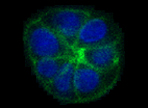
| HOME |
| MEMBERS |
| RESEARCH |
| PUBLICATIONS |
| PROTOCOLS |
| DATA/TOOLS |
| POSITIONS AVAILABLE |
| LINKS |
| CONTACT |
Research |
|
We use genetically engineered mouse models and three-dimensional tissue culture models of the tumor microenvironment to address important outstanding questions in the molecular oncology of breast and other solid tumors.
For sample movies from some of our work click here
1. Functional characterization of recurrent cancer mutations. As part of our molecular diagnostic work and clinical service we frequently encounter patients whose tumors have mutations which have not been functionally characterized. We use a variety of cellular and molecular approaches to explain how these genetic alterations contribute to cancer initiation and progression. Examples include genetically engineered mouse models with mammary-specific expression of mutant GATA3 and in vitro characterization of novel mutations in BRAF.
2. Novel drug targets in triple-negative breast cancer.
Triple-negative breast cancer lacks expression of ER, PR and HER2 which are the drug targets for our most commonly used breast cancer targeted therapies. This is frequently an aggressive disease which disproportionately affects young women. Our goal is to better understand the biology that underlies triple-negative breast cancer so that we may identify and validate appropriate targets for therapy.
3. We have a long standing interested in genes regulating mammary gland development and in understanding how such genes might affect tumor development later in life. We have described key roles for the EGFR ligand, Amphiregulin, in the development and progression of p53-dependent tumors in mouse models.
4. Mechanisms of resistance to targeted therapy. We perform longitundinal sequencing on specimens from patients undergoing treatment with molecularly targeted cancer therapy in order to understand genetically-based mechanisms of resistance. In this program, we have characterized mechanisms of acquired resistance to MET and ROS1 inhibtion in breast cancer, BRAF inhibition in melanoma and checkpoint immunotherapy in both lung cancer and melanoma.